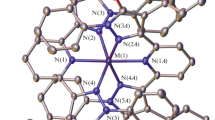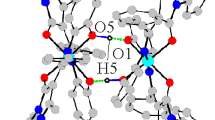Abstract
Complexes of the general formula, ML2 [M = CuII, NiII, CoII and OVIV; L = 1,2,3,5,6,7,8,8a-octahydro-3-hydroxyimino-N-(4-X-phenyl)-l-phenyl-5-(phenylmethylene)-2-naphthalenecarboxamide (X = H, Me, OMe, Cl)] have been prepared and characterized on the basis of elemental analysis, magnetic moments and i.r., e.p.r. and electronic spectra. These metal complexes contain the N4 chromophore with the ligand coordinating through nitrogens of the azomethine and deprotonated anilide functions. C.v. measurements indicate that the copper(II) complexes are quasi-reversible in acetonitrile solution. Square planar and square pyramidal structures are assigned respectively to the copper(II) and oxovanadium(IV) complexes, whereas tetrahedral geometry is assigned to the nickel(II) and cobalt(II) complexes. Deprotonated anilide nitrogen is involved in coordination and the presence of an electron-donating group para to the anilide function decreases the ΔE values of the d–d transitions while the value is found to increase when electron-withdrawing groups are substituted. Line spacing in the e.p.r. spectra of the copper(II) and oxovanadium(IV) complexes increases when methyl group is para to the anilide group, and decreases when this group is replaced by methoxy or chloro. The ν(C–N) of the anilide group and the ν(C-N) of the azomethine function of the oxime metal complexes are metal-sensitive and the blue shift for the above stretching frequencies follows the order: copper(II) > oxovanadium(IV) > nickel(II) ≈ cobalt(II).
Similar content being viewed by others
References
V.S. Babu, A. Ramesh, P. Raguram and R. Ragavanaidu, Polyhedron, 1, 607 (1982)
B.D. Gupta and W.U. Malik, Indian J. Chem., 7, 724 (1969).
J.W. Smith in S. Patai (Ed.), The Chemistry of Carbon-Nitrogen Double Bond, Interscience Publishers Ltd., London, 1970.
G. Wang and J.C. Chang, Synth. React. Inorg. Met-Org. Chem., 21, 897 (1991).
P.S. Patel, A. Ray and M.M. Patel, Proc. Indian Acad. Sci., Chem. Sci., 104, 471 (1992).
A. Sharma and R. Kumar, Bull. Chem. Soc Jpn., 66, 1084 (1993).
H. Diehl, The Application of the Dioximines to Analytical Chemistry, C.F. Smith & Co., Columbus, Ohio, 1940.
J. Das, J. Indian Chem. Soc., 54, 278 (1977).
K. Dey, J. Sci. Ind. Res., 33, 76 (1974).
A. Chakravorty, Coord. Chem. Rev., 13, 1 (1974).
P.R. Athappan, S. Sevagapandian and G. Rajagopal, Synth. React. Inorg. Met.-Org. Chem., 26, 647 (1996).
L.J. Bellamy, The Infrared Spectra of Complex Molecules, 3rd Edn., Chapman & Hall, London, 1975.
H.A.O. Hill and K.A. Rospin, J. Chem. Soc., 619 (1969).
A. Keterup and W. Riepe, Z. Anal. Chem., 252, 1 (1970).
P.C. Trivedi and B.C. Halder, J. Indian Chem. Soc., 50, 81 (1973).
B.S. Pannu and S.L. Chopra, J. Indian Chem. Soc., 51, 387 (1974).
N. Nonayama, J. Inorg. Nucl. Chem., 37, 59 (1975).
J. Lewis and R.G. Wilkins, Modern Coordination Chemistry, Interscience, New York, 1960.
I.S. Ahuja and R. Sriramulu, Indian J. Chem., 19A, 909 (1980).
M. Kelton, A.B.P. Lever and B.S. Ramasamy, Can. J. Chem., 48, 3185 (1970).
S.F.A. Kettle, Coordination Compounds, ELBS (1969).
A.B.P. Lever, Inorganic Electronic Spectroscopy, Elsevier, Amsterdam, 1968.
C.J. Ballhausen and H.B. Gray, Inorg. Chem., 1, 111 (1962).
R. Amudesan, J. Whelan and B. Bosnich, J. Am. Chem. Soc., 99, 6730 (1977).
D. Kivelson and R. Neiman, J. Chem. Phys., 35, 149 (1961).
J. Casanova, G. Alzueta, L. David and G. Gatteschi, Inorg. Chim. Acta, 211, 183 (1993)
L.J. Boucher, E.C. Tynan and T.F. Yen, Spectral Properties of Oxovanadium(IV) Complexes in Electron Spin Resonance of Metal complexes., Plenum Press, New York, 1969.
F. Patrick, H. Britt, M.K. Calson and O. Hodgson, Inorg. Chem., 33, 3794 (1994).
P.S. Zacharias and A. Ramachandriah, Polyhedron, 4, 113 (1985).
S.K. Mandal and K. Nag, J. Chem. Soc., Dalton Trans., 2429 (1983).
Author information
Authors and Affiliations
Rights and permissions
About this article
Cite this article
Sevagapandian, S., Rajagopal, G., Nehru, K. et al. Copper(II), nickel(II), cobalt(II) and oxovanadium(IV) complexes of substituted β-hydroxyiminoanilides. Transition Metal Chemistry 25, 388–393 (2000). https://doi.org/10.1023/A:1007067326655
Issue Date:
DOI: https://doi.org/10.1023/A:1007067326655




